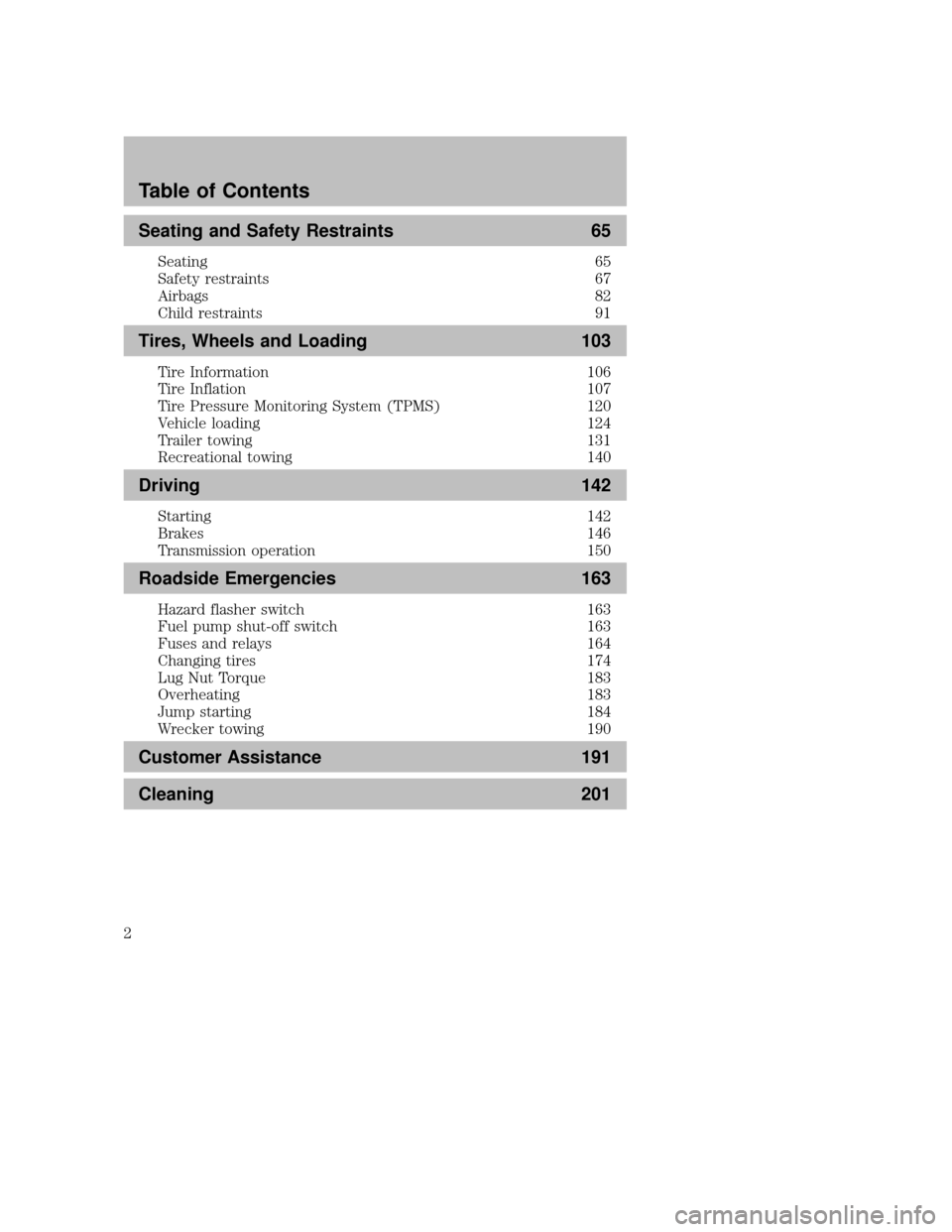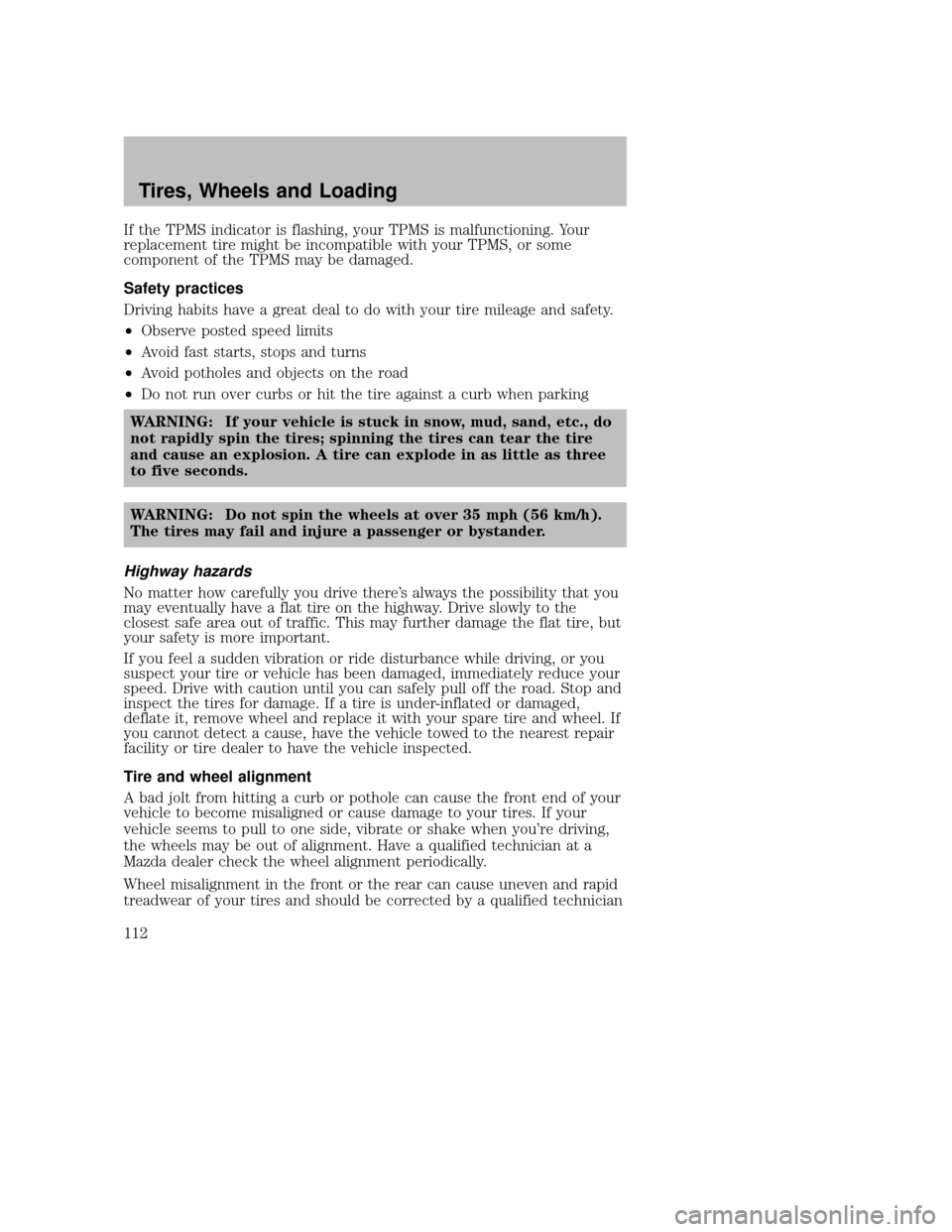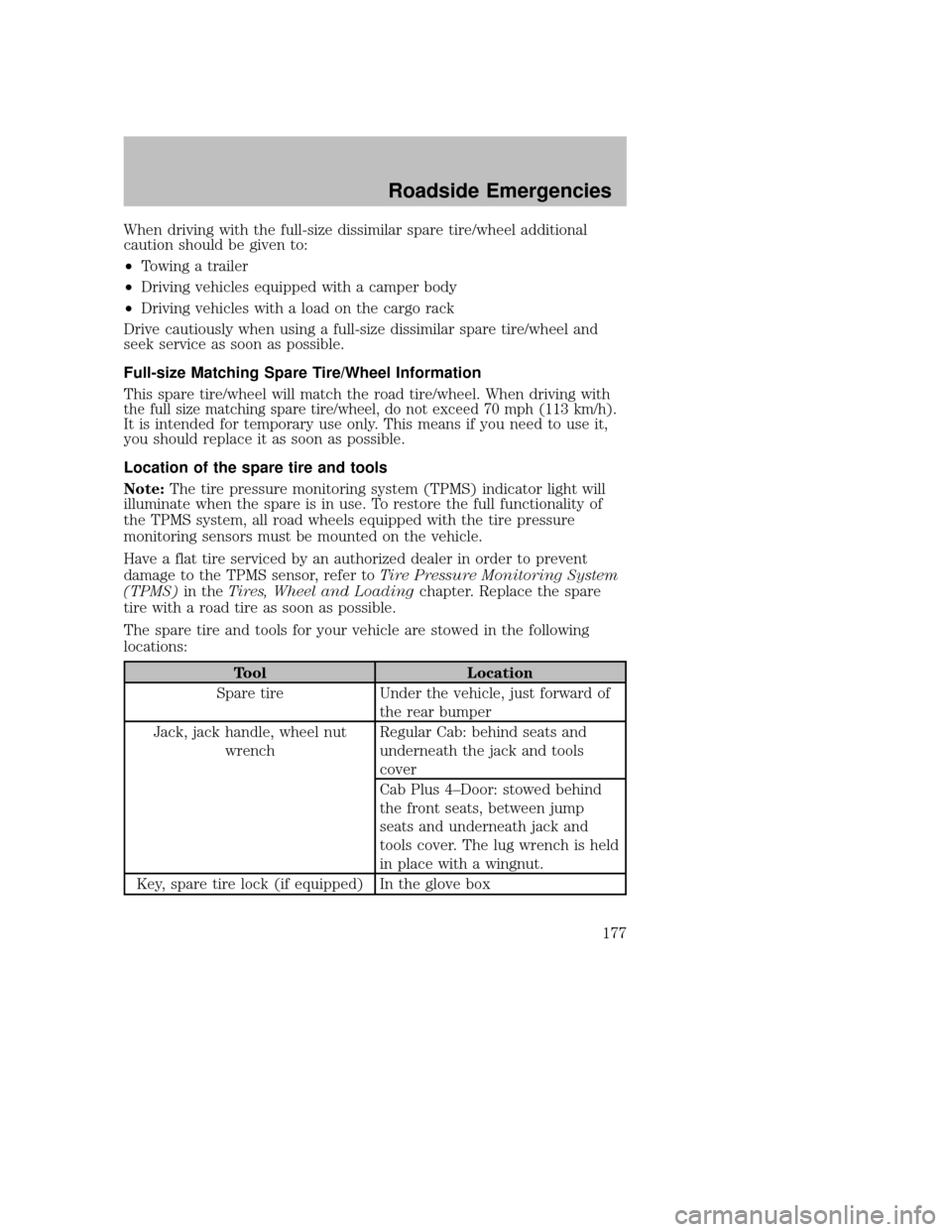TPMS MAZDA MODEL B-SERIES 2007 Owners Manual (in English)
[x] Cancel search | Manufacturer: MAZDA, Model Year: 2007, Model line: MODEL B-SERIES, Model: MAZDA MODEL B-SERIES 2007Pages: 272, PDF Size: 3.4 MB
Page 2 of 272

Seating and Safety Restraints65
Seating 65
Safety restraints 67
Airbags 82
Child restraints 91
Tires, Wheels and Loading103
Tire Information 106
Tire Inflation 107
Tire Pressure Monitoring System (TPMS) 120
Vehicle loading 124
Trailer towing 131
Recreational towing 140
Driving142
Starting 142
Brakes 146
Transmission operation 150
Roadside Emergencies163
Hazard flasher switch 163
Fuel pump shut-off switch 163
Fuses and relays 164
Changing tires 174
Lug Nut Torque 183
Overheating 183
Jump starting 184
Wrecker towing 190
Customer Assistance191
Cleaning 201
Table of Contents
2
REVIEW COPY ——
2007 B-Series(mbs), Owners Guide (post-2002-fmt) (own2002),Market:Canadian_French (fr_can)
Page 112 of 272

If the TPMS indicator is flashing, your TPMS is malfunctioning. Your
replacement tire might be incompatible with your TPMS, or some
component of the TPMS may be damaged.
Safety practices
Driving habits have a great deal to do with your tire mileage and safety.
•Observe posted speed limits
• Avoid fast starts, stops and turns
• Avoid potholes and objects on the road
• Do not run over curbs or hit the tire against a curb when parking
WARNING: If your vehicle is stuck in snow, mud, sand, etc., do
not rapidly spin the tires; spinning the tires can tear the tire
and cause an explosion. A tire can explode in as little as three
to five seconds.
WARNING: Do not spin the wheels at over 35 mph (56 km/h).
The tires may fail and injure a passenger or bystander.
Highway hazards
No matter how carefully you drive there’s always the possibility that you
may eventually have a flat tire on the highway. Drive slowly to the
closest safe area out of traffic. This may further damage the flat tire, but
your safety is more important.
If you feel a sudden vibration or ride disturbance while driving, or you
suspect your tire or vehicle has been damaged, immediately reduce your
speed. Drive with caution until you can safely pull off the road. Stop and
inspect the tires for damage. If a tire is under-inflated or damaged,
deflate it, remove wheel and replace it with your spare tire and wheel. If
you cannot detect a cause, have the vehicle towed to the nearest repair
facility or tire dealer to have the vehicle inspected.
Tire and wheel alignment
A bad jolt from hitting a curb or pothole can cause the front end of your
vehicle to become misaligned or cause damage to your tires. If your
vehicle seems to pull to one side, vibrate or shake when you’re driving,
the wheels may be out of alignment. Have a qualified technician at a
Mazda dealer check the wheel alignment periodically.
Wheel misalignment in the front or the rear can cause uneven and rapid
treadwear of your tires and should be corrected by a qualified technician
REVIEW COPY ——
2007 B-Series (mbs), Owners Guide (post-2002-fmt) (own2002),Market:Canadian_French (fr_can)
Tires, Wheels and Loading
112
Page 120 of 272

TIRE PRESSURE MONITORING SYSTEM (TPMS)
Each tire, including the spare (if
provided), should be checked
monthly when cold and inflated to
the inflation pressure recommended
by the vehicle manufacturer on the
vehicle placard or tire inflation pressure label. (If your vehicle has tires
of a different size than the size indicated on the vehicle placard or tire
inflation pressure label, you should determine the proper tire inflation
pressure for those tires.)
As an added safety feature, your vehicle has been equipped with a tire
pressure monitoring system (TPMS) that illuminates a low tire pressure
telltale when one or more of your tires is significantly under-inflated.
Accordingly, when the low tire pressure telltale illuminates, you should
stop and check your tires as soon as possible, and inflate them to the
proper pressure. Driving on a significantly under-inflated tire causes the
tire to overheat and can lead to tire failure. Under-inflation also reduces
fuel efficiency and tire tread life, and may affect the vehicle’s handling
and stopping ability.
Please note that the TPMS is not a substitute for proper tire
maintenance, and it is the driver’s responsibility to maintain correct tire
pressure, even if under-inflation has not reached the level to trigger
illumination of the TPMS low tire pressure telltale.
The Tire Pressure Monitoring System complies with part 15 of the FCC
rules and with RSS-210 of Industry Canada. Operation is subject to the
following two conditions: (1) This device may not cause harmful
interference, and (2) This device must accept any interference received,
including interference that may cause undesired operation.WARNING: The Tire Pressure Monitoring System is NOT a
substitute for manually checking tire pressure. The tire
pressure should be checked periodically (at least monthly)
using a tire gauge, see Inflating your tiresin this chapter.
Failure to properly maintain your tire pressure could increase
the risk of tire failure, loss of control, vehicle rollover and
personal injury.
REVIEW COPY ——
2007 B-Series (mbs), Owners Guide (post-2002-fmt) (own2002),Market:Canadian_French (fr_can)
Tires, Wheels and Loading
120
Page 121 of 272

Changing tires with TPMS
Each road tire is equipped with
a tire pressure sensor fastened
to the inside rim of the wheel.
The pressure sensor is covered
by the tire and is not visible
unless the tire is removed. The
pressure sensor is located
opposite (180 degrees) from the
valve stem. Care must be taken
when changing the tire to avoid
damaging the sensor.It is
recommended that you always have
your tires serviced by an authorized
dealer.
The tire pressure should be checked
periodically (at least monthly) using
an accurate tire gauge, refer to
Inflating your tires in this chapter.
Understanding your Tire Pressure Monitoring System (TPMS)
The Tire Pressure Monitoring System measures pressure in your four
road tires and sends the tire pressure readings to your vehicle. The Low
Tire Warning Lamp will turn ON if the tire pressure is 25% below the
pressure listed on the Tire Label located on the B-Pillar or the edge of
the driver’s door. Once the light is illuminated, your tires are under
inflated and need to be inflated to the manufacturer’s recommended tire
pressure. Even if the light turns ON and a short time later turns OFF,
your tire pressure still needs to be checked.
When your temporary spare tire is installed (if equipped)
When one of your road tires needs to be replaced with the temporary
spare (T-type spare/Mini spare or Dissimilar spare), the TPMS system
will continue to identify an issue to remind you that the damaged road
wheel/tire needs to be repaired and put back on your vehicle.
To restore the full functionality of the Tire Pressure Monitoring System,
have the damaged road wheel/tire repaired and remounted on your
vehicle. For additional information, refer to Changing tires with TPMS
in this section.
REVIEW COPY ——
2007 B-Series (mbs), Owners Guide (post-2002-fmt) (own2002),Market:Canadian_French (fr_can)
Tires, Wheels and Loading
121
Page 122 of 272

When you believe your system is not operating properly
The main function of the Tire Pressure Monitoring System is to warn you
when your tires need air. It can also warn you in the event the system is
no longer capable of functioning as intended. Please refer to the
following chart for information concerning your Tire Pressure Monitoring
System:
Low Tire Pressure
Warning LightPossible cause Customer Action Required
Solid Warning Light Tire(s) under-inflated1. Check your tire pressure to
ensure tires are properly
inflated; refer to
Inflating
your tires in this chapter.
2. After inflating your tires to
the manufacturer’s
recommended inflation
pressure as shown on the Tire
Label (located on the edge of
driver’s door or the B-Pillar)
the vehicle must be driven for
at least two minutes over
20 mph (32 km/h) before the
light will turn OFF.
Spare tire in use Your temporary spare tire is in use. Repair the damaged road
wheel/tire and reinstall it on
the vehicle to restore system
functionality. For a description
on how the system functions,
refer toWhen your temporary
spare tire is installed in this
section.
TPMS
malfunction If your tires are properly
inflated and your spare tire is
not in use and the light
remains ON, have the system
inspected by your authorized
dealer.
REVIEW COPY ——
2007 B-Series
(mbs), Owners Guide (post-2002-fmt) (own2002),Market:Canadian_French (fr_can)
Tires, Wheels and Loading
122
Page 123 of 272

Low Tire Pressure
Warning LightPossible cause Customer Action Required
Flashing Warning
Light Spare tire in use Your temporary spare tire is in
use. Repair the damaged road
wheel and re-mount it on the
vehicle to restore system
functionality. For a description
of how the system functions
under these conditions, refer to
When your temporary spare
tire is intalledin this section.
TPMS
malfunction If your tires are properly
inflated and your spare tire is
not in use and the TPMS
warning light is still ON, have
the system inspected by your
authorized dealer.
When inflating your tires
When putting air into your tires (such as at a gas station or in your
garage), the Tire Pressure Monitoring System may not respond
immediately to the air added to your tires.
It may take up to two minutes of driving over 20 mph (32 km/h) for the
light to turn OFF after you have filled your tires to the recommended
tire pressure.
How temperature affects your tire pressure
The Tire Pressure Monitoring System (TPMS) monitors tire pressure in
each pneumatic tire. While driving in a normal manner, a typical
passenger tire inflation pressure may increase approximately 2 to 4 psi
(14 to 28 kPa) from a cold start situation. If the vehicle is stationary
over night with the outside temperature significantly lower than the
daytime temperature, the tire pressure may decrease approximately 3 psi
(20.7 kPa) for a drop of 30° F (16.6° C) in ambient temperature. This
lower pressure value may be detected by the TPMS as being lower than
the recommended inflation pressure and activate the TPMS warning for
low tire pressure. If the low tire pressure warning light is ON, visually
check each tire to verify that no tire is flat. If one or more tires are flat,
repair as necessary. Check air pressure in the road tires. If any tire is
underinflated, carefully drive the vehicle to the nearest location where
air can be added to the tires. Inflate all the tires to the recommended
inflation pressure.
REVIEW COPY ——
2007 B-Series (mbs), Owners Guide (post-2002-fmt) (own2002),Market:Canadian_French (fr_can)
Tires, Wheels and Loading
123
Page 174 of 272

Fuse/RelayLocation Fuse Amp
Rating Power Distribution Box
Description
40 — Not used
41 10A* Automatic transmission
42 7.5A* Trailer tow (left turn)
43 20A* A/C relay coil, Engine sensors,
VMV solenoid, EGR solenoid,
Heated PCV
44 15A* Ignition coil, Capacitor
45A — Wiper HI/LO relay
45B — Wiper Park/Run relay
46A — A/C clutch solenoid
46B — Washer pump relay
47 — PCM relay
48A — Fuel pump relay, Fuel injectors
relay
48B — Fog lamp relay
51 — Not used
52 — Not used
53 — Not used
54 — Not used
55 — Blower relay
56 — Starter relay
* Mini Fuses ** Maxi Fuses
CHANGING THE TIRES
If you get a flat tire while driving:
• do not brake heavily.
• gradually decrease the vehicle’s speed.
• hold the steering wheel firmly.
• slowly move to a safe place on the side of the road.
Note: The tire pressure monitoring system (TPMS) indicator light will
illuminate when the spare is in use. To restore the full functionality of
the monitoring system, all road wheels equipped with tire pressure
monitoring sensors must be mounted on the vehicle.
REVIEW COPY ——
2007 B-Series (mbs), Owners Guide (post-2002-fmt) (own2002),Market:Canadian_French (fr_can)
Roadside Emergencies
174
Page 175 of 272

Have a flat serviced by an authorized dealer in order to prevent damage
to the TPMS sensor, refer toChanging tires with TPMSin theTires,
Wheels and Loading chapter. Replace the spare tire with a road tire as
soon as possible.
WARNING: The use of tire sealants may damage your tires. The
use of tire sealants may also damage your Tire Pressure
Monitoring System and should not be used.
WARNING: Refer to Tire Pressure Monitoring System (TPMS)
in the Tires, Wheels and Loading chapter for important
information. If the tire pressure monitor sensor becomes
damaged, it will no longer function.
Dissimilar spare tire/wheel information WARNING: Failure to follow these guidelines could result in an
increased risk of loss of vehicle control, injury or death.
If you have a dissimilar spare tire/wheel, then it is intended for
temporary use only. This means that if you need to use it, you should
replace it as soon as possible with a road tire/wheel that is the same size
and type as the road tires and wheels that were originally provided by
Mazda. If the dissimilar spare tire or wheel is damaged, it should be
replaced rather than repaired.
A dissimilar spare tire/wheel is defined as a spare tire and/or wheel that
is different in brand, size or appearance from the road tires and wheels
and can be one of three types: 1. T-type mini-spare: This spare tire begins with the letter “T” for tire
size and may have “Temporary Use Only” molded in the sidewall
2. Full-size dissimilar spare with label on wheel: This spare tire
has a label on the wheel that states: “THIS TIRE AND WHEEL FOR
TEMPORARY USE ONLY”
When driving with one of the dissimilar spare tires listed above, do not:
• Exceed 50 mph (80 km/h)
• Load the vehicle beyond maximum vehicle load rating listed on the
Safety Compliance Label
• Tow a trailer
REVIEW COPY ——
2007 B-Series (mbs), Owners Guide (post-2002-fmt) (own2002),Market:Canadian_French (fr_can)
Roadside Emergencies
175
Page 177 of 272

When driving with the full-size dissimilar spare tire/wheel additional
caution should be given to:
•Towing a trailer
• Driving vehicles equipped with a camper body
• Driving vehicles with a load on the cargo rack
Drive cautiously when using a full-size dissimilar spare tire/wheel and
seek service as soon as possible.
Full-size Matching Spare Tire/Wheel Information
This spare tire/wheel will match the road tire/wheel. When driving with
the full size matching spare tire/wheel, do not exceed 70 mph (113 km/h).It is intended for temporary use only. This means if you need to use it,
you should replace it as soon as possible.
Location of the spare tire and tools
Note: The tire pressure monitoring system (TPMS) indicator light will
illuminate when the spare is in use. To restore the full functionality of
the TPMS system, all road wheels equipped with the tire pressure
monitoring sensors must be mounted on the vehicle.
Have a flat tire serviced by an authorized dealer in order to prevent
damage to the TPMS sensor, refer to Tire Pressure Monitoring System
(TPMS) in theTires, Wheel and Loading chapter. Replace the spare
tire with a road tire as soon as possible.
The spare tire and tools for your vehicle are stowed in the following
locations:
Tool Location
Spare tire Under the vehicle, just forward of
the rear bumper
Jack, jack handle, wheel nut wrench Regular Cab: behind seats and
underneath the jack and tools
cover
Cab Plus 4–Door: stowed behind
the front seats, between jump
seats and underneath jack and
tools cover. The lug wrench is held
in place with a wingnut.
Key, spare tire lock (if equipped) In the glove box
REVIEW COPY ——
2007 B-Series (mbs), Owners Guide (post-2002-fmt) (own2002),Market:Canadian_French (fr_can)
Roadside Emergencies
177
Page 266 of 272

Starting your
vehicle ........................142–143, 145jump starting ..........................184
Steering wheel tilting .........................................49
T
Tether anchors ............................99
Tilt steering wheel ......................49
Tire Pressure Monitoring
System (TPMS) Roadside Emergencies ...........174
Tires, Wheels and Loading ....120
Tires ...........................105–106, 174 alignment ................................112
care ..........................................109
changing ..........................174, 179
checking the pressure ............109
inflating ...................................107
label .........................................119
replacing ..................................111
rotating ....................................113
safety practices .......................112
sidewall information ...............114
snow tires and chains ............124
spare tire .........................175, 177
terminology .............................106
tire grades ...............................106
treadwear ........................105, 110
Towing .......................................131 recreational towing .................140
trailer towing ..........................131
wrecker ....................................190
Traction-lok rear axle ...............149 Transfer case
fluid checking .........................250
Transmission automatic operation ...............150
brake-shift interlock (BSI) ....150
fluid, checking and adding
(manual) .................................249
lubricant specifications ..........253
manual operation ....................154
Turn signal ..................................41
V
Vehicle Identification Number
(VIN) ..........................................259
Vehicle loading ..........................124 camper bodies ........................141
Ventilating your vehicle ...........145
W
Warning chimes ...........................17
Warning lights (see Lights) .......12
Washer fluid ..............................220
Water, Driving through .............162
Windows power .........................................51
Windshield washer fluid and
wipers ..........................................49 checking and adding fluid .....220
checking and cleaning ............220
replacing wiper blades ...........221
Wrecker towing .........................190
REVIEW COPY ——
2007 B-Series (mbs), Owners Guide (post-2002-fmt) (own2002),Market:Canadian_French (fr_can)
Index
266